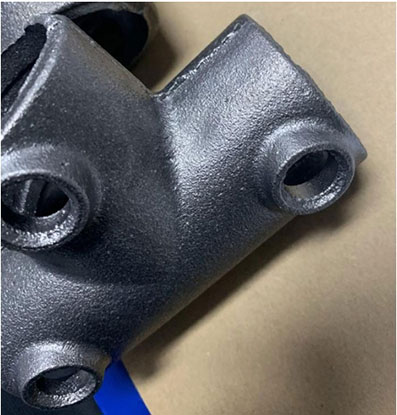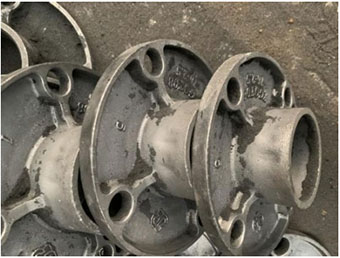Small nodular cast iron parts generally have thin wall thickness, small casting modulus, low casting process yield, and are difficult to use graphitization expansion to achieve self shrinkage. During the production process, casting defects such as shrinkage porosity and concave shrinkage often occur. The formation of shrinkage and collapse is related to the solidification mode of ductile iron liquid, the wide solidification temperature range, and the small temperature gradient during solidification. Silicon is an element that increases the solidification range of molten iron. The higher the silicon content, the wider the solidification range of molten iron,At the same time, silicon is an element that increases the activity of carbon element. With high silicon content, the more graphite precipitates in the early stage when the molten iron solidifies. The higher the silicon content in the molten iron, the greater the tendency for small ductile iron castings to form shrinkage porosity and concavity. The formation of shrinkage and depression defects in ductile iron castings is often difficult to solve due to process limitations by placing risers and cooling iron. The fundamental solution is to reasonably control the silicon content of the molten iron and use a special spheroidizing agent – pure lanthanum spheroidizing agent, to avoid excessive precipitation of graphite balls in the early stages of solidification, thereby maximizing the expansion effect of graphitization in the later stages of solidification.
Small nodular cast iron castings have a small modulus, making it difficult to achieve self shrinkage through graphitization expansion. During solidification, the temperature gradient is small, which can easily lead to shrinkage porosity and concave defects. Small nodular cast iron parts often suffer from shrinkage and indentation defects, which are often limited by the process and the structure of the casting itself is not easily solved by placing risers and cold iron. Therefore, it is particularly important to analyze the causes and influencing factors of shrinkage porosity and concavity in small ductile iron castings, in order to find other solutions.
The solidification process of ductile iron liquid belongs to the paste solidification mode, where graphite balls grow under the austenite shell (divorced eutectic), and the movement speed of carbon atoms is limited, resulting in a slow growth rate and delaying the formation of a solid outer shell on the surface of the casting. When the casting solidifies, when the filling metal liquid forms a closed container solid shell in the mold cavity, if a vacuum space is locally formed inside the shell, and the strength and load-bearing capacity of the shell are insufficient at high temperatures, the shell will collapse under atmospheric pressure and form a collapse. There is no difference in surface roughness compared to other castings that do not collapse, that is, they also have contact with the surface of the sand mold wall, replicating the traces on the surface of the mold wall. This is the main basis for distinguishing between shrinkage and air pockets on the surface; The location is on the surface of the casting with a thick cross-section or structural hot spot; According to the pouring position of the casting, there are three types of shrinkage areas: bottom shrinkage, side shrinkage, and top shrinkage.
Pure iron carbon alloys undergo eutectic solidification at a constant temperature during solidification, but due to the presence of many alloying elements, especially silicon, the actual eutectic solidification process of cast iron alloys occurs within a certain temperature range. The wider the solidification range, the expansion effect of early precipitated graphite cannot achieve self shrinkage due to the coexistence of a large amount of metal liquid and solid or insufficient strength of the casting shell. When the expansion of isolated areas of precipitated graphite in the later solidification stage is not enough to offset the liquid shrinkage of molten iron, shrinkage porosity and collapse will occur. Therefore, an increase in the content of alloy elements in the molten iron that can increase the eutectic solidification range will increase the tendency of castings to produce shrinkage porosity and shrinkage defects, while an increase in the content of alloy elements in the molten iron that can reduce the eutectic solidification range will reduce the tendency of castings to produce shrinkage porosity and shrinkage defects. The higher the silicon content in the molten iron, the larger the solidification range of the molten iron; At the same time, due to the increased activity of carbon by silicon, the amount of graphite precipitated in the early stage of solidification increases, and the amount of graphite precipitated in the later stage decreases. Therefore, ductile iron has a high silicon content, and castings are prone to shrinkage porosity and concavity. Small nodular cast iron parts exhibit shrinkage and indentation defects. In addition to designing the casting process, riser, and controlling the pouring temperature reasonably, measures are mainly taken from the following two aspects.
When solving the problems of shrinkage and concavity defects in small and medium-sized castings, it is believed that increasing the number of graphite balls can prevent shrinkage and concavity defects in castings, so every effort is made to increase the number of graphite balls. Having a higher number of graphite balls does not necessarily reduce casting porosity, but may actually increase porosity. Only when the size distribution range of graphite balls is large, having a higher number of graphite balls is beneficial for reducing porosity. Excessive addition of inoculant (overgrowth) or the use of bismuth to increase the number of graphite balls can result in an excess of graphite balls with similar structural characteristics and consistent size. Although this metallographic structure looks good, it is not conducive to eliminating casting shrinkage defects, but rather increases the tendency for casting shrinkage. For small and medium wall thickness castings, it is appropriate to control the silicon content between 2.5% and 2.8% to prevent shrinkage and indentation defects. When producing low-grade small thin-walled ductile iron parts, foundries often avoid white spots and ensure elongation by increasing the silicon content. Many foundries increase the silicon content of castings to 2.9% to 3.2%, which widens the solidification range of the molten iron eutectic and increases the tendency of casting shrinkage and concave defects, resulting in casting shrinkage and concave defects. When small and medium-sized ductile iron castings experience shrinkage and indentation defects in actual production, they are often affected by the process and the structure of the castings, especially when using the coated sand shell process and producing small ductile iron castings using clay sand vertical lines. It is not easy to use riser and cold iron processes. At this time, controlling the silicon content of the molten iron within a reasonable range and reducing the eutectic solidification range of the molten iron are effective ways to solve the shrinkage and indentation defects of castings.
Conclusion
(1) The occurrence of shrinkage and indentation defects in cast iron parts is related to the solidification mode of the molten metal. The paste solidification mode of alloys is prone to the formation of shrinkage and indentation defects; The metal liquid that solidifies layer by layer is prone to forming shrinkage defects.
(2) The wider the solidification temperature range of the alloy, the smaller the solidification temperature gradient, and the greater the tendency of the alloy to produce shrinkage porosity and concavity during solidification; The higher the silicon content of the molten iron, the wider the solidification temperature range of the molten iron, and the easier it is for the molten iron to form shrinkage defects.
(3) Reasonable silicon content and the use of pure lanthanum spheroidizing agent can effectively reduce the amount of graphite precipitation in the early stage of solidification of molten iron, increase the amount of graphite precipitation in the later stage of solidification, and effectively prevent the occurrence of shrinkage porosity and concave defects in small ductile iron castings.


